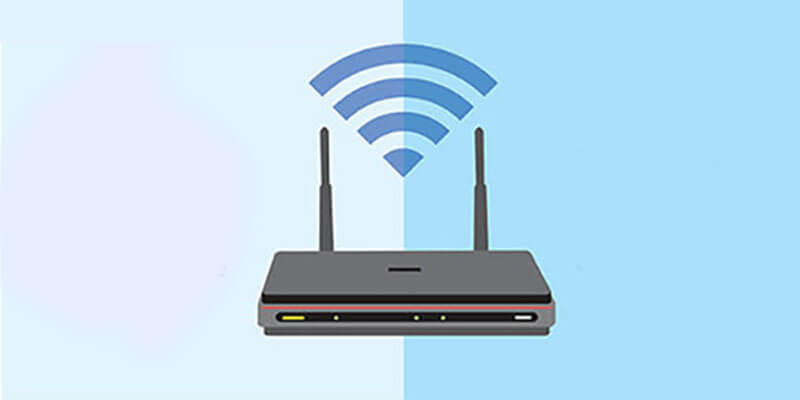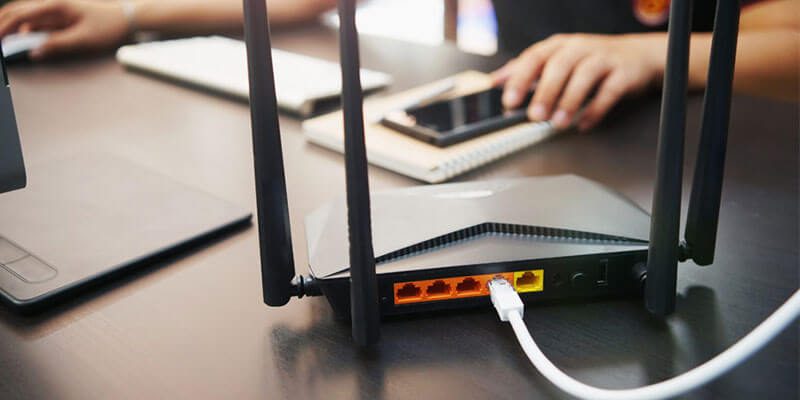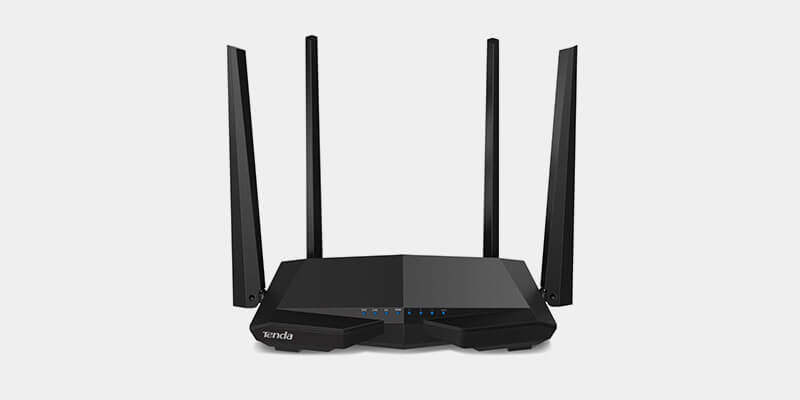- What Is Dual-Band WiFi – 2.4 GHz vs 5 GHz WiFi
- What Does Dual-Band Mean For Wifi?
- Difference Between Dual-Band & Single Band Wifi
- What Is Dual-Band Wifi
- How Does Dual Band Wifi Work?
- Advantages & Disadvantages Of Dual-Band
- Advantages
- Disadvantages
- Top Five Dual-Band WiFi Routers
- Is Dual-Band Wifi Better?
- Conclusion:
What Is Dual-Band WiFi – 2.4 GHz vs 5 GHz WiFi
If you have a new router, chances are it’s a dual-band router. Newer laptops, smartphones, and other devices also support the dual-band standard. But what exactly is dual-band WiFi, and how does it benefit you?
In a nutshell, dual-band WiFi is the ability of a router to broadcast on two different frequencies: 2.4GHz and 5GHz. Most routers that support the 802.11n standard are dual-band. The 2.4GHz frequency is the more commonly used of the two, and as a result, it’s more congested. That’s because many devices still use the 802.11g standard, which uses the 2.4GHz frequency.
In addition, many common household items such as microwaves and cordless phones operate on a 2.4GHz frequency. The 5GHz frequency is newer and, therefore, not as congested.
It can also carry more data than the 2.4GHz frequency. The trade-off is that the 5GHz frequency doesn’t have as much range as the 2.4GHz frequency. In this essay, we will explain “what is dual-band WiFi.”
What Does Dual-Band Mean For Wifi?
Dual-band routers operate on two different frequency bands: 2.4GHz and 5GHz. It means that they can send and receive data on both frequencies, allowing for better performance and a more reliable connection.
Most devices only use the 2.4GHz band, so you can avoid interference and get faster speeds by using a dual-band router. Additionally, the 5GHz band is less crowded than the 2.4GHz band, so you can expect better performance in areas with a lot of wireless traffic.
If you have a device that only supports the 2.4GHz band, you can still connect to a dual-band router, but you will only be able to use the 2.4GHz band. Your device will not be able to take advantage of the 5GHz band.
Difference Between Dual-Band & Single Band Wifi
Dual-band routers transmit and receive data on two different frequency spectrums: 2.4GHz and 5GHz. It allows for faster speeds and less interference than a single-band router. Dual-band routers are also better at handling multiple devices because each band can be assigned to specific devices or tasks. For example, you could use the 2.4GHz band for basic activities like web browsing and streaming video while using the 5GHz band for more intensive tasks such as online gaming or downloading large files.
A single-band router transmits and receives data on a single frequency spectrum: 2.4GHz. It can lead to slower speeds and more interference than dual-band routers. Single-band routers are also not as good at handling multiple devices because each device is competing for bandwidth on the same frequency.
In general, if you have a lot of devices that need WiFi and you do a variety of activities (e.g., streaming video, online gaming, browsing), then a dual-band router would be a better choice. If you only have a few devices or don’t do a lot of activities that use WiFi, then a single-band router may be enough.
What Is Dual-Band Wifi
Dual-band WiFi is a type of WiFi that uses two different frequency bands to provide wireless internet access. They are 2.4GHz and 5GHz. Dual-band routers allow devices to connect to the internet using either band, depending on the strength of the signal and the capabilities of the device.
Dual-band WiFi is beneficial because it offers faster speeds and greater range than single-band WiFi. Additionally, dual-band routers are less likely to experience interference from other devices operating on the same frequency band. It makes them ideal for households with multiple devices that must connect to the internet simultaneously.
If you want to buy a router that offers dual-band WiFi, be sure to check the frequency bands it uses before making your purchase. Many routers advertise themselves as dual-band but only support one or two of the frequency bands. Ensure the router you choose can support your devices’ frequency band(s).
How Does Dual Band Wifi Work?
Dual-band WiFi is a type of WiFi that uses two frequency bands to send and receive data. These frequency bands are the 2.4GHz band and the 5GHz band.
The 2.4GHz band is the older, more common frequency band that most routers use. The 5GHz band is newer and offers faster speeds than the 2.4GHz band.
Dual-band WiFi routers use two frequency bands, the 2.4GHz band, and the 5GHz band, to send and receive data. Devices can connect to the internet using either frequency band, allowing devices to choose the frequency band that offers the best performance.
Dual-band WiFi also has increased reliability and range compared to single-band WiFi routers. It is because dual-band routers can use both frequency bands simultaneously to send and receive data.
Dual-band WiFi is becoming more popular as more devices are using the 5GHz band to connect to the internet. WiFi Certified 6, the latest version of the WiFi certification, includes dual-band WiFi support.
Advantages & Disadvantages Of Dual-Band
Dual-band routers are quickly becoming the norm, as people are looking for ways to get the most out of their wireless networks. But they have advantages and disadvantages.
Advantages
The main advantage of dual-band routers is that they can provide both 2.4GHz and 5GHz connections. It means that you can connect devices that use either frequency band without worrying about compatibility issues.
If you have a laptop that uses the 2.4GHz band and a phone that uses the 5GHz band, you can connect them both to your dual-band router without any problems. It is impossible with single-band routers, which can only support one frequency band.
Dual-band routers can also provide faster speeds and better range than single-band routers. It is because the 5GHz frequency band has less interference and can travel farther than the 2.4GHz frequency band.
Disadvantages
One disadvantage of dual-band WiFi is that it can be more expensive than single-band WiFi. Additionally, if you have a lot of devices that need to connect to the internet, using dual-band WiFi can be more complicated and frustrating because you may have to switch between different bands depending on which device you are using.
Another downside of dual-band WiFi is that it can sometimes cause interference with other wireless devices in your home or office. This interference can cause problems with streaming video or audio, online gaming, and other activities that require a strong and stable signal.
Dual-band WiFi is a great technology with many benefits. However, it also has some disadvantages that you should know before deciding whether to use it.
Top Five Dual-Band WiFi Routers
The Netgear 4-Stream AX1800 is a dual-band router that supports the 2.4GHz and 5GHz bands simultaneously. It delivers up to 1800Mbps speeds on each band. Additionally, the 4-stream AX1800 features Beamforming technology, which helps to optimize the signal strength and coverage area for each device. This results in improved performance and less interference for all connected devices. Plus, the included six antennas provide maximum range and reliability.
TP-Link AX3000 is one of the best dual-band routers you can buy. It supports the latest 802.11ax standard, which means it can deliver very fast speeds. Our tests reached speeds of up to 1,200Mbps on the 5GHz band and 600Mbps on the 2.4GHz band. That’s enough to handle even the most demanding online tasks easily. Thanks to its four external antennas, the AX3000 also offers an excellent range. The app also provides handy features like parental controls and guest networking.
Asus’s AX1800 is a WiFi (802.11ax) router capable of speeds of up to 1.8Gbps. It’s a dual-band router that supports both the 2.4GHz and 5GHz frequencies, and it has four external antennas that help improve its range. The AX1800 also has some features that make it a good choice for gaming, including support for Asus’s GameFirst technology and a built-in game accelerator. It also has parental controls and guest networking. If you’re looking for a WiFi 6 router with a dual-band that can deliver fast speeds for gaming, the Asus AX1800 is a good option.
TP-Link’s AX5400 is a dual-band router that’s great for home use. It has 4 Gigabit Ethernet ports and supports speeds of up to 5400Mbps. The router also has a USB 3.0 port for connecting external storage devices. The AX5400 is a great choice for a home router because it offers good performance and is very easy to set up. The router comes with a web-based interface that makes it easy to configure and get it up and running. If you’re looking for a dual-band router that’s easy to use and offers good performance, the TP-Link AX5400 is a great option.
Linksys E5600 is a dual-band router that can handle both the 2.4GHz and 5GHz bands. The Linksys E5600 is a powerful and versatile router that can give you the best possible performance for both your 2.4GHz and 5GHz devices. If you have a lot of devices that use the 2.4GHz frequency band, the E5600 can help them all connect without slowing down your network. And if you have any devices that use the 5GHz frequency band, the E5600 can help them connect to the internet at lightning-fast speeds.
Is Dual-Band Wifi Better?
Dual-band WiFi is a type of WiFi that uses two different frequency bands to send and receive data. They are 2.4GHz and 5GHz. Like smartphones and laptops, many newer devices have dual-band WiFi antennas built-in.
So which should you use? That depends on your needs. Dual-band WiFi is often better than single-band WiFi because it can offer faster speeds and greater range. It is because the two frequency bands offer different benefits.
The 2.4GHz band is better for covering long distances, while the 5GHz band is better for providing high speeds. The 2.4GHz band is older and has less capacity than the 5GHz band, but it’s also less congested and can travel further. The 5GHz band is newer, has more capacity, and is less likely to be interfered with.
A lot of people wonder if they should switch to dual-band WiFi if they already have a single-band router. It depends on the type of devices you have and how far away from your router they are. If all of your devices support dual-band WiFi and are close to the router, switching to a dual-band router will probably provide a noticeable speed increase.
Conclusion:
We hope that you understand “what is dual-band WiFi.” We explained the whole concept briefly. If you still have any queries, you can research online.


